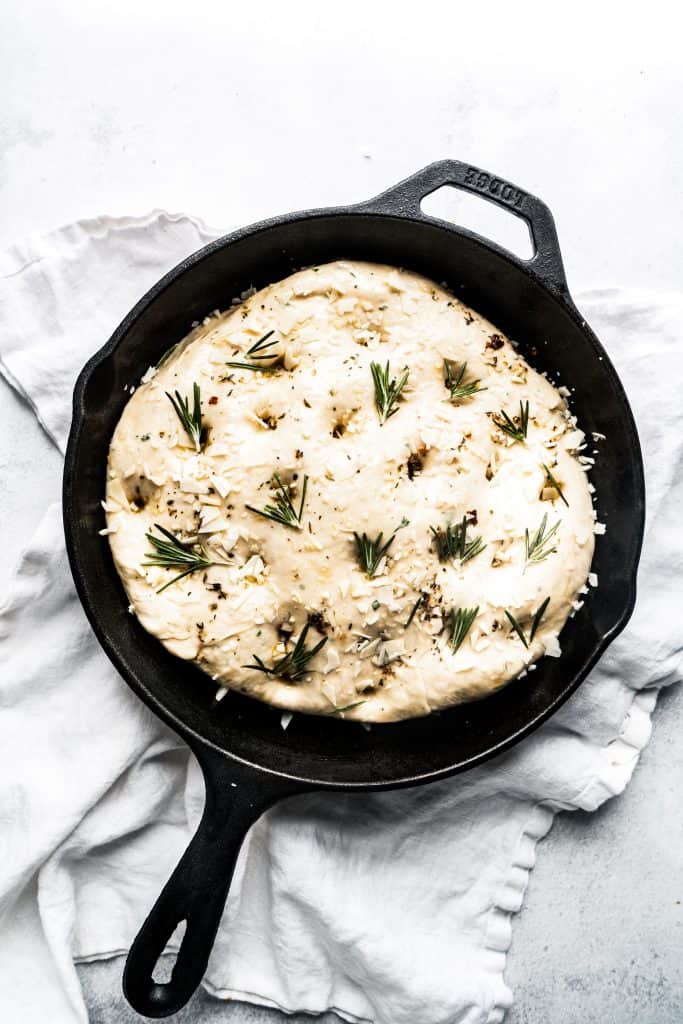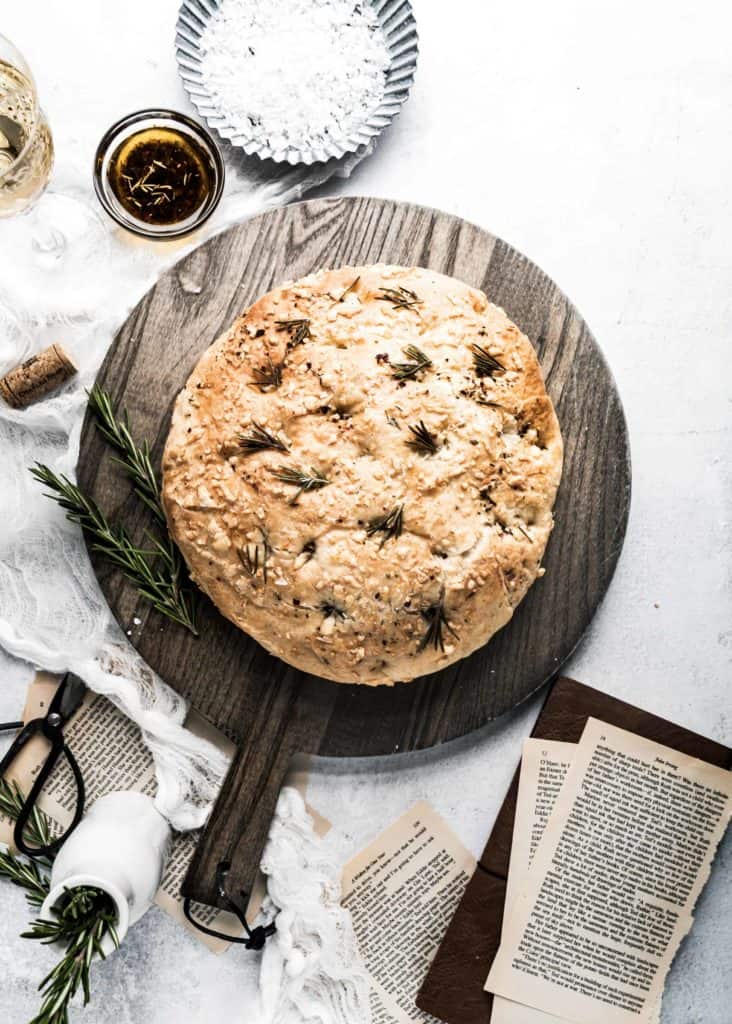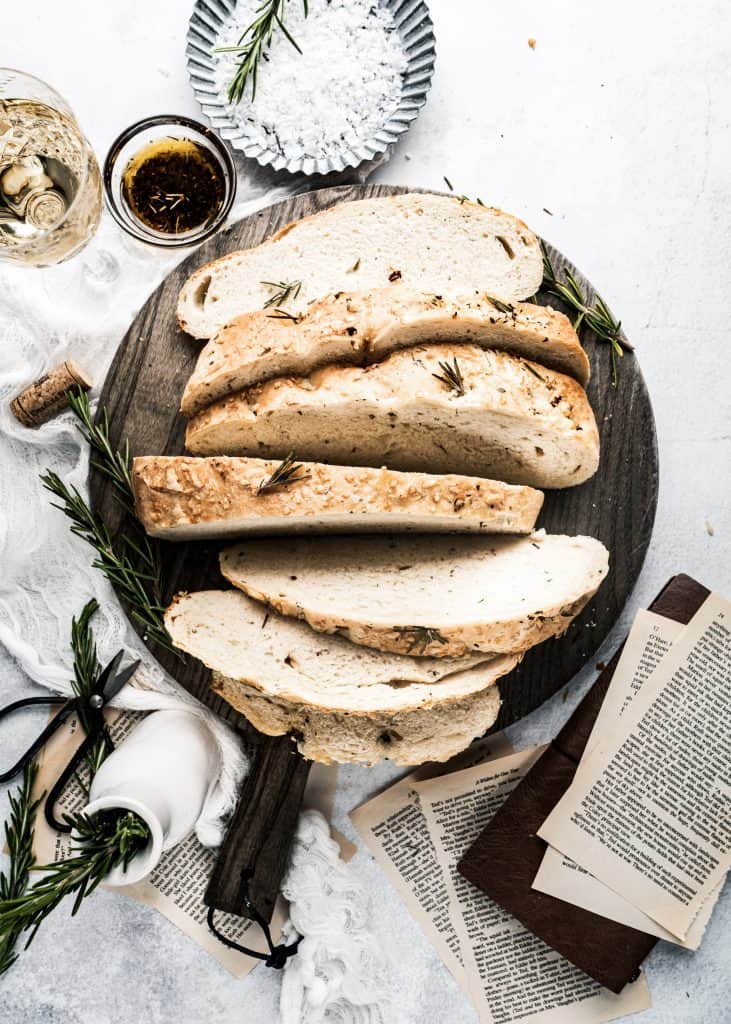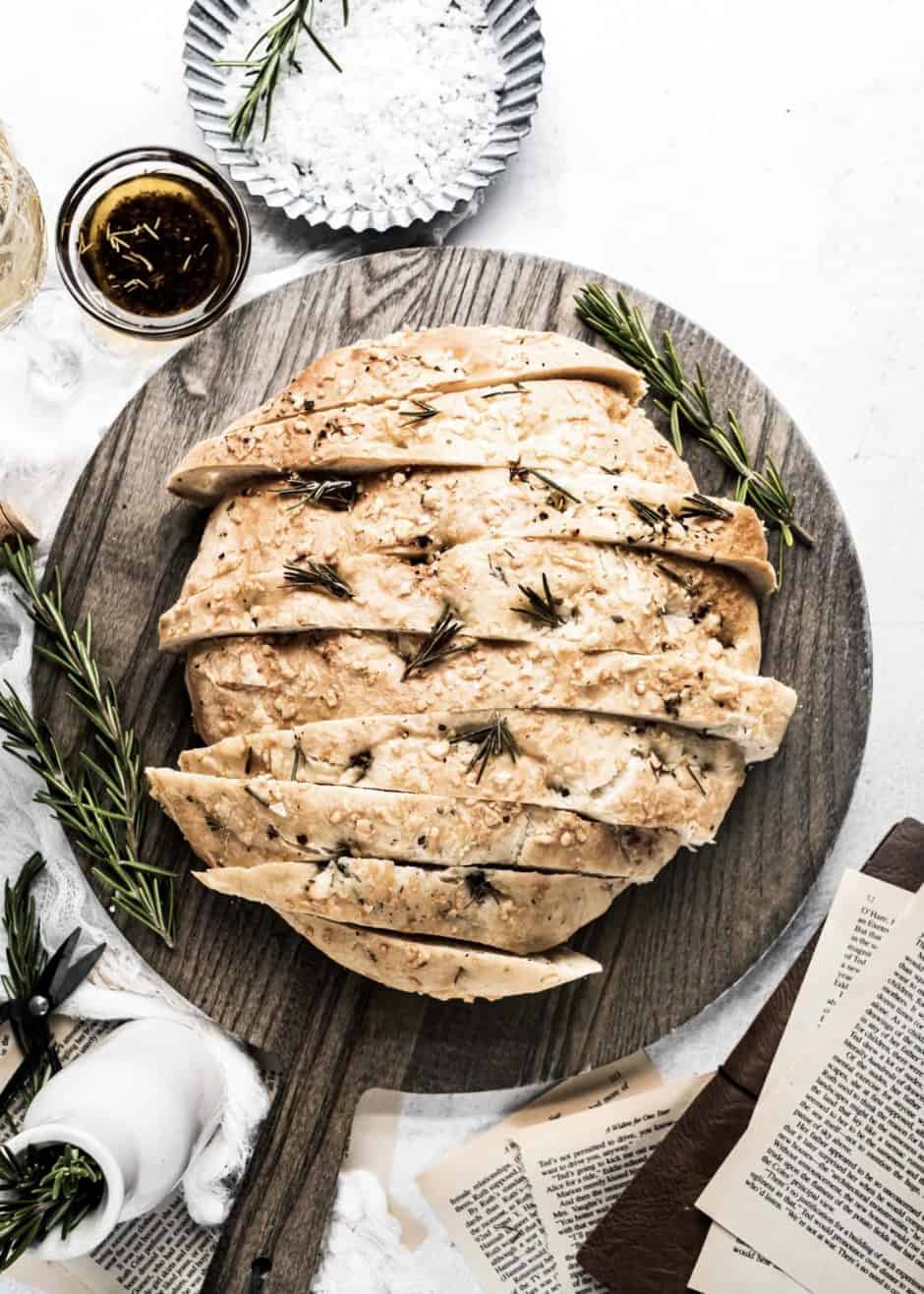Asiago Rosemary Focaccia has a crispy crust and fluffy center with delicious Asiago and rosemary flavor in every bite! Pair this easy-to-make homemade bread with your favorite soups, salads, and so much more!
When I was in high school my mom got a job working at a bakery. They made scones, cookies, biscuits and lots and lots of bread. On Sundays, the employees rotated shifts, and they were able to run the bakery alone. They would sell Saturday’s leftover bread, and take a percentage of the profits. These were my favorite day, because I was able to come in and help!
I fell in love with baking during my time there, and it inspired me to go to culinary school! My favorite bake was focaccia (pronounced “foe-kah-cha”). I loved the fluffy inside and the crusty exterior of this Italian bread, and all the herbs and the flavor of olive oil really had me hooked!
How does focaccia differ from pizza?
Although both Italian foods are similar, pizza and focaccia are slightly different. As a general rule of thumb, a classic Italian-style pizza crust will be less than half an inch thick while most focaccia will be at least three quarters of an inch thick. Also, focaccia is most commonly served at room temperature!

Tips for making a great focaccia
- Use quality ingredients: a good quality extra virgin olive oil, a great sea salt, and yeast
- Let the dough rest: You want to let the flavor develop, so let the dough rest for anywhere from 8 to 48 hours after the first kneading. It allows for enough time for the dough to ferment, which will ensure great flavor in your rosemary focaccia.
- Be generous with the olive oil: most steps in making rosemary focaccia involve olive oil, so don’t skimp! Olive oil is used in the dough itself, brushed in the bowl while the dough rests, on the baking sheet, and brushed on top! Focaccia is also delicious dipped in herbed olive oil alongside pasta or salad!
How do you make focaccia?
- Let the yeast bloom. Use warm water (about 110 degrees F) and sugar. (I highly recommend using a thermometer to measure the temperature of the water, so that it is just right). We add sugar to the water because the yeast needs sugar to produce carbon dioxide – the leavening gas that causes the dough to rise. If there is not enough sugar available, the dough will rise slowly or not at all.
- Knead the dough. Gradually add in the flour, olive oil, and salt. Then knead for 5 minutes using the dough attachment or a stand mixer, or knead the dough by hand.
- First dough rise. Shape the dough into a ball and place it in an olive oil greased mixing bowl, and cover with a damp towel. Let the dough rest in the fridge for 12-18 hours.
- Remove from the fridge and deflate. Deflate the dough and use your hands to turn the dough in the oil, creating a rough ball. Knead in Asiago cheese and place in olive oil greased bowl. Don’t touch the dough again for 2 hours.
- Prepare the dough. Heat oven to 400°F. Transfer the dough to a large parchment-covered baking sheet or seasoned cast iron pan. Use your fingers to poke deep dents — not exaggerating, poke all the way down until you touch the baking sheet — all over the surface of the dough. Then drizzle a tablespoon or two of olive oil evenly all over the top of the dough, and sprinkle evenly with grated Asiago cheese, fresh rosemary needles, and sea salt.
- Bake. Bake for 20 minutes, or until the dough is slightly golden and cooked through.
- Serve. Remove from the oven, and drizzle with a little more olive oil if desired. Slice, and serve warm.
What should I serve with focaccia?
You can pair focaccia with many different dishes! IT can be enjoyed on its own, with some herbed olive oil, or alongside Asparagus Salad with Tomatoes and Basil, Broccoli cheddar soup, or pesto shrimp fettuccine!



Asiago Rosemary Focaccia
- Prep Time: 15 minutes
- 12 hours: resting
- Cook Time: 20 minutes
- Total Time: 35 minutes
- Yield: 6-8 1x
- Category: Appetizer
- Method: Bake
- Cuisine: Italian
Ingredients
1 1/3 cup warm water (about 110°F)
2 teaspoons sugar or honey
1 (0.25 ounce) package active-dry yeast
3 1/2 cups all purpose flour
1/4 cup extra virgin olive oil, plus more for drizzling
1/2 cup shredded Asiago cheese
2 teaspoons flaky sea salt, plus extra for sprinkling*
2 sprigs fresh rosemary
Instructions
- Let the yeast bloom in warm water in a large mixing bowl. Use warm water (about 110 degrees F) and sugar. (I highly recommend using a thermometer to measure the temperature of the water, so that it is just right). Let it bloom for 10 minutes.
- Knead the dough. Gradually add in the flour, olive oil, and salt. Then knead for 5 minutes using the dough attachment or a stand mixer, or knead the dough by hand.
- First dough rise. Shape the dough into a ball and place it in an olive oil greased mixing bowl, and cover with a damp towel. Let the dough rest in the fridge for 12-18 hours.
- Remove from the fridge and deflate. Deflate the dough and use your hands to turn the dough in the oil, creating a rough ball. Knead in 1/2 the Asiago cheese and place in olive oil greased bowl. Don’t touch the dough again for 2 hours.
- Prepare the dough. Heat oven to 400°F. Transfer the dough to a large parchment-covered baking sheet or seasoned cast iron pan. Use your fingers to poke deep dentsall over the surface of the dough. Then drizzle a tablespoon or two of olive oil evenly all over the top of the dough, and sprinkle evenly with remaining grated Asiago cheese, fresh rosemary needles, and sea salt.
- Bake. Bake for 20 minutes, or until the dough is slightly golden and cooked through.
- Serve. Remove from the oven, and drizzle with a little more olive oil if desired. Slice, and serve warm.
You can also FOLLOW ME on INSTAGRAM, PINTEREST, and FACEBOOK for more great recipes!
Want to pin this for later? Click on the image below!








No Comments